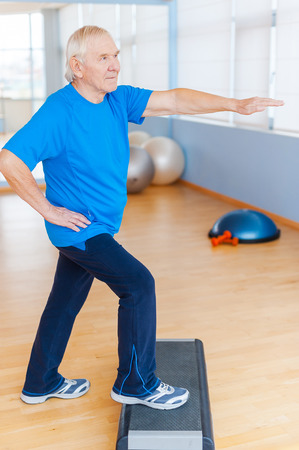
If a client tells you they have or have had prostate cancer you need to do extra research before programming exercise for him. Here are four common questions with detailed answers so you can be equipped to work with this special population.
Is it ok to exercise with prostate cancer?

The evidence for physical activity in reducing anxiety and depression, while increasing general-well being for those with prostate cancer is fairly substantial.
Improving well-being can have a dramatic beneficial effect on sexual function as well. Consistent exercise helps lower insulin, blood sugar, and improve overall cardiovascular health, all of which have a positive impact on erectile dysfunction and libido.
The American Cancer Society recommends that adults should get at least 150 minutes of moderate intensity or 75 minutes of vigorous intensity activity each week.
Aerobic exercise burns calories to keep weight under control. Those with prostate cancer should avoid prolonged bicycling because of the pressure on the perennial area. Also, exercises that improve bone density are a better choice.
Does exercise help prostate cancer recovery?
Exercise helps prostate cancer recovery because it improves overall health, reduces the side effects of treatments, and improves the chances of surviving cancer.
An exercise program can help heart health, bone density, and decrease the risk of diabetes and obesity. Data indicates that obesity increases the aggressiveness of prostate cancer, and thus mortality.
Exercise can decrease blood sugar levels, which lower insulin levels and also helps to lower inflammation. There also appears to be a positive association between insulin levels, inflammation and prostate cancer risk.
After a complete assessment and medical history, you will find that a client with prostate cancer will most likely be on Androgen Deprivation Therapy (ADT). It is important to understand the side effects of ADT because it will affect the exercise programming.
The side effects of ADT include loss of muscle, increase in fat mass and osteoporosis. Risk for diabetes and heart disease also increases. The risk of suffering the above side effects can be reduced by exercise.
What kind of exercise is good after prostate cancer surgery?
Since ADT causes a loss of muscle mass, a good fitness routine must emphasize strength training, which will help to increase muscle mass. It can be performed with weights, bands, machines, or body weight. Some of the treatments can cause sarcopenia, which is a change in the fat to muscle ratio.
Strength training is important because it can increase muscle mass and decrease fat. Strength training can also help decrease the risk of osteoporosis, which can be an issue after chemotherapy. Strength training will not only increase muscle mass, it will also help to strengthen bones.
The muscle that surrounds the prostate may be weakened from cancer surgery and treatments. Some cancers and cancer treatments may result in incontinence. Clients may become incontinent, with less control over their urine flow. There are different types of incontinence, ranging from mild to severe.
Some examples are: stress incontinence which can cause a person to leak urine during activities such as coughing, laughing, sneezing, or exercising, urge incontinence – a sudden, urgent need to urinate, and continuous incontinence – not being able to control the bladder at all.
Kegel exercises strengthen pelvic floor muscles to control urine flow. The pelvic floor muscles are comprised of the bladder, sphincter and the pubococcygeus muscle. These muscles are used to stop the flow of urine.
Help clients find their pelvic floor muscles by having them squeeze their sphincter and contracting the urethra to stop the flow of urine when using the bathroom.
Kegels are great for prostate cancer patients because they minimize incontinence and can improve erectile issues. They can help control incontinence without medication or surgery. It is wise to start Kegel exercises before surgery and treatments.
Perform the Kegel 10 times holding for 5 seconds each. Try to do this four times per day. Take a 5-second break between each repetition.
It may take several weeks or months to be able to contract muscles for 5 seconds at a time, or to repeat it 10 times. If they perform the Kegel several times per day, their pelvic floor strength should improve.
What are some exercise precautions for clients with prostate cancer?
• Fatigue– Monitor energy levels and adapt exercises accordingly.
• Osteoporosis– Take note if this is a diagnosis and modify exercises as needed.
• Bone Metastases– There is a high risk of breaking a bone when cancer cells are lodged in the bone. Swimming and riding a stationary bike are safe exercises. Perform balance exercises and exercises that have a low risk of falling.
• Cardiopulmonary Issues– An exercise program for someone who has weak heart muscles or an irregular heartbeat should begin under supervision.
• Lymphedema– This common side effect can occur after the removal of lymph nodes and is identified by swelling of the limb or trunk. If a client has or is at risk for lymphedema, he or she needs to be evaluated by a lymphedema specialist before starting and exercise program.
If exercise is cleared by the specialist, have your client consider using a compression garment. Maintaining range of motion and avoiding infection is important. Modifications and slow progression are important components for exercise programming. Refer the client to a doctor with the presence of swelling.
• Neuropathy– A common side effect of cancer treatment that affects the nervous system. Causes numbness, loss of sensation, tingling and pain. If the hands are affected, it may be difficult to safely hold on to hand weights. Using tubing or resistance bands with handles is safer. Balance training is advised for peripheral neuropathy.
• Myelosuppression – Use caution with machines and equipment because of bruising and bleeding from having fewer platelets. Treatments can affect bone marrow activity. Red and white blood cells and platelets are produced in the bone marrow.
• Neutropenia and Anemia– Neutropenia, which is a decrease in white blood cells, may develop. A decrease in white blood cells can increase your risk of infection. It is important to avoid infections. Stay away from crowded places and places that are not cleaned regularly.
Studies Support Use of Exercise
Numerous studies support the use of exercise in the treatment of prostate cancer.
Brian Focht, PhD at Ohio State, reported at the AICR convention that functional ability increased dramatically as did the quality of life for those that exercise and side effects of ADT were reversed.
Ying Wang, senior epidemiologist at the American Cancer Society’s epidemiology research program concluded that after a prostate cancer diagnosis, men who were the most physically active had a 34% lower risk of dying from prostate cancer compared with men who exercised the least. Men who either maintained or increased their exercise level also benefited. Dr. Wang would like physicians to promote physical activity to their prostate cancer patients.
We Can Help Our Clients
It is very likely that you will have a client with a prostate cancer diagnosis and will need to be aware of the exercise implications.
We can help clients with prostate cancer. High levels of physical activity have a lower rate of disease progression and reduced mortality from prostate cancer. Exercise can also decrease stress, anxiety, and depression.
Exercise plays a role in all-around improved physical and mental health and should be considered in the treatment plan for prostate cancer patients and survivors.







